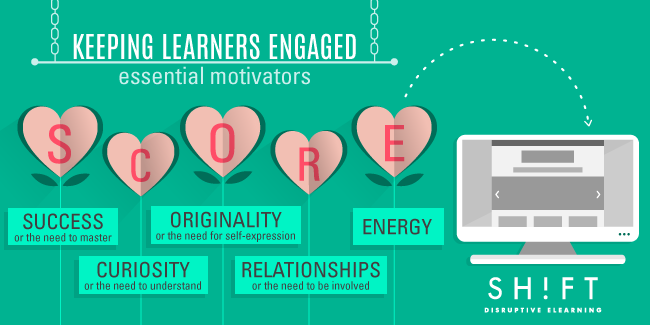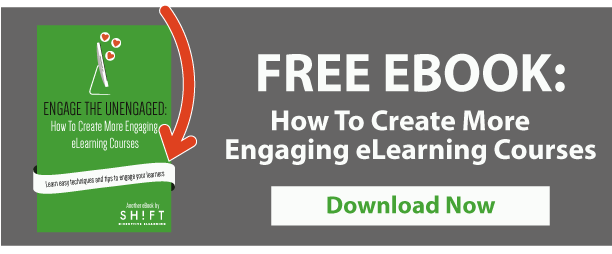eLearning and Learner Engagement:
What is learner engagement? It’s not just about keeping your students busy. It’s keeping your students motivated, giving them the tools that they need to learn, and fostering a sense of pride in achieving personal goals. It’s about encouraging learning for the pure love of it, not just for the sake of getting grades. When learners are working hard to absorb the material the course offers, and they’re committed to learning that comes without reward other than the learning itself, then they’re engaged.
Engagement requires an emotional connection between the content and the learner. And the only way we can do that is by knowing what drives people to spend time, effort, and energy learning your content. This post will help you understand this thoroughly and even learn how to apply it to your eLearning.
SCORE
According to researchers Harvey Silver, Richard Strong, and Amy Robertson, students are driven by four essential motivators, which can be defined by the acronym SCORE. Those motivators are:
- Success, or the need to master the material
- Curiosity, or the need to understand the material
- Originality, or the need for self-expression
- Relationships, or the need to be involved with others, and finally,
- Energy
These goals are all motivators. Taken together, they add up to student engagement.
When the eLearning conditions are right, students will build the motivation to learn. They will, essentially, feel driven to complete the course material.
All of these goals are intrinsic motivators, and they provide your students with the energy that they need in order to deal with the complexities of the course material.

Ask Yourself These Questions
As an eLearning professional, you should be considering the following:
- Are the conditions right for your students to succeed?
- What makes your students curious?
- How can you help your students achieve self-expression?
- How can you motivate your students to learn?
Increasingly, SCORE suggests that students who are able to shape their own learning experience learn better. They feel greater ownership over the learning process, they have higher levels of self-esteem, their relationships with their peers and educators are better, and they’re more motivated. Not surprisingly, this leads to higher levels of achievement.
On the other hand, failing to engage with learners results in disengagement and disillusionment.
Engaging Learners
So, how do you drive engagement in eLearning? Harness the elements of SCORE with these tips:
1) Encourage Them to Succeed
Students need to engage in work that helps them to feel successful and competent. They want to be challenged in ways that allow them to demonstrate their competence.
WHAT YOU NEED TO DO: Accordingly, your job as an eLearning professional is to state clearly the criteria for success, and then provide the feedback that is needed for the student to work toward his or her goals. Every achievement, big or small, will lead to further motivation.
2) Show That Success is Possible
Creating an environment where it’s possible for students to master their skills is essential. If your learner thinks that he or she will fail no matter big the effort, then there can be no motivation. But if a student thinks that things are doable and goals are achievable, then motivation naturally arises.
WHAT YOU NEED TO DO: Start off slow, with tasks that are relatively easy to achieve. Then progress to more complex tasks. Encourage learners to work to their capabilities, and don’t set the bar low, but don’t set it ridiculously high either.
Daniel Pink, author of the book "A Whole New Mind", clearly stated that for creating an environment where mastery is possible four essentials are required: autonomy, clear goals, immediate feedback and Goldilocks tasks.
3) Stimulate and Sustain Curiosity
Curiosity is the strongest underlying motivator for learning – and that’s what successful eLearning is built on. It is especially an important factor in motivating people to learn or at least seek information. If you can get learners to click next or hit play or choose a path because they genuinely want to know – you have succeeded in creating an effective eLearning course.
WHAT YOU NEED TO DO: Through the entire course you should try to stimulate curiosity. In other words, give learners something to be curious about. For example, wrap a storyaround the content or use any kind of event that introduces conflict. You can also encourage curiosity by attracting learners’ attention or raising their interest. You can, for instance, use questions. Leading the student to a conclusion by the use of questions rather than simply imparting information must be your goal. This will make learners search for answers in their minds. Also, by exposing them to their knowledge gaps at the beginning of your course you will activate their curiosity.
4) Encourage Originality
The main objective of training is to facilitate critical thinking. Students should not parrot learning back that they’ve learned by rote. They should be using their creative abilities to learn and master the material on offer. Problem-solving is a key component of eLearning.
WHAT YOU NEED TO DO: Ideally, you should encourage meaningful self-expression in your students. Let them make choices, and define for themselves the ways in which they want to approach learning. Allow them autonomy and opportunities for self-discovery.
5) Encourage Peer Relationships
Peer relationships and interaction are essential for improving student engagement. In fact, experts encourage us to use social media, tools that promote collaboration and information sharing (Junco, Helbergert, & Loken, 2011), in academic settings to promote student engagement and facilitate better student learning (Kabilan, Ahmad, & Abidin, 2010).
This is because today’s students are intensely social – witness the amount of time they spend on networking sites, for example. They crave constant connection and communication, and their learning environment has to both reflect and support that need.
When others support or encourage what an individual is doing, expect a significant impact on his or her motivation.
WHAT YOU NEED TO DO: If you can facilitate the building of peer-to-peer relationships in your eLearning course, students will be more engaged, and more likely to complete the course. Give your students the opportunity of talking with one another before, after, and even during class, and encourage them to collaborate. Google Hangout sessions and the occasional Skype conference call are useful tools for you to use. And of course, encourage your students to follow each other on Twitter.
CONCLUSION
As an eLearning professional, you now understand the importance of learner engagement. Now, make it happen!
Sources:
http://www.ascd.org/publications/educational-leadership/sept95/vol53/num01/
http://sites.roosevelt.edu/djnoble/courses/innovative-teaching-eportfolio/



